 W
WAnthodon is an extinct genus of pareiasaurid parareptile from the Permian period of South Africa and Tanzania.
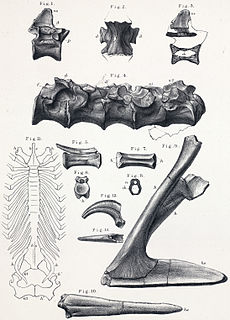 W
WAristosuchus is a genus of small coelurosaurian dinosaur whose name was derived from the Greek ἄριστος and σουχος. It shared many characteristics with birds.
 W
WBrachydiastematherium transylvanicum is the westernmost species of brontothere, with the first fossils of it being found in Transylvania, Romania. In comparison with other brontothere fossils, it is suggested that B. transylvanicum would have had an elongated head, not unlike Dolichorhinus, and be about 2 meters at the withers.
 W
WChondrosteosaurus was a sauropod from Early Cretaceous England.
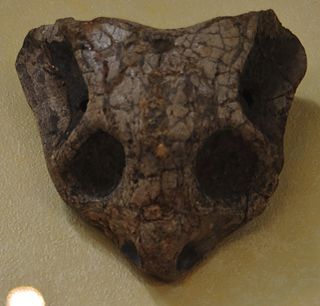 W
WCistecephalus is an extinct genus of dicynodont therapsid from the Late Permian of southern Africa. It was a small, specialised, burrowing dicynodont, possibly with habits similar to a modern mole. The head was flattened and wedge-shaped, the body long, and the forelimbs very strong, with similarities in structure to the forelimb of modern burrowing mammals.
 W
WEndothiodon is an extinct genus of large dicynodont from the Late Permian. Like other dicynodonts, Endothiodon was an herbivore, but it lacked the two tusks that characterized most other dicynodonts. The anterior portion of the upper and lower jaw are curved upward, creating a distinct beak that is thought to have allowed them to be specialized grazers.
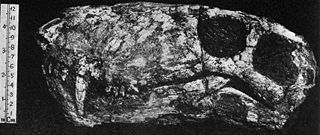 W
WGorgonops is an extinct genus of therapsid which lived about 260-254 million years ago, during the Late Permian. It was a typical representative of the suborder Gorgonopsia, the dominant predators of their day, which in the largest forms grew to over three metres long.
 W
WIdiocetus is a genus of extinct cetaceans of the family Balaenidae.
 W
WLeptadapis is a genus of adapiform primate that lived in Europe during the middle Eocene. Fossils of the genus have been found in the Escanilla Formation of Spain and Egerkingen in Switzerland.
 W
WMacroscaphites is an extinct cephalopod genus included in the Ammonoidea that lived during the Barremian and Aptian stages of the Early Cretaceous. Its fossils have been found throughout most of Europe and North Africa.
 W
WMonoclonius is a dubious genus of herbivorous ceratopsian dinosaur found in the Late Cretaceous layers of the Judith River Formation in Montana, United States, and the uppermost rock layers of the Dinosaur Park Formation in Alberta, Canada dated to between 75 and 74.6 million years ago.
 W
WNyctosaurus is a genus of nyctosaurid pterodactyloid pterosaur, the remains of which have been found in the Niobrara Formation of the mid-western United States, which, during the late Cretaceous Period, was covered in an extensive shallow sea. The genus Nyctosaurus has had numerous species referred to it, though how many of these may actually be valid requires further study. At least one species possessed an extraordinarily large antler-like cranial crest.
 W
WPareiasaurus is an extinct genus of anapsid reptile from the Permian period. It was a typical member of its family, the pareiasaurs, which take their name from this genus.
 W
WParonychodon was a theropod dinosaur genus. It is a tooth taxon, often considered dubious because of the fragmentary nature of the fossils, which include "buckets" of teeth from many disparate times and places but no other remains, and should be considered a form taxon.
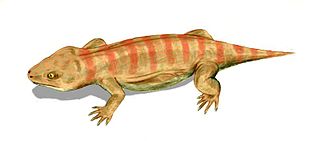 W
WProcolophon is a genus of lizard-like procolophonid reptiles that first appeared in the Late Permian (Lopingian) of South Africa, Brazil, and Antarctica. It persisted through the Permian–Triassic extinction event, but went extinct in the early Triassic. The type species is P. trigoniceps.
 W
WProtolabis is an extinct genus of camelid endemic to North America. It lived from the Early to Late Miocene 20.4—5.3 mya, existing for approximately 15 million years . Fossil distribution is widespread from Nicaragua, Central America to Montana and throughout the western U.S.
 W
WPteranodon is a genus of pterosaur that included some of the largest known flying reptiles, with wingspans over 7 meters. They lived during the late Cretaceous geological period of North America in present-day Kansas, Alabama, Nebraska, Wyoming, and South Dakota. More fossil specimens of Pteranodon have been found than any other pterosaur, with about 1,200 specimens known to science, many of them well preserved with nearly complete skulls and articulated skeletons. It was an important part of the animal community in the Western Interior Seaway.
 W
WScaloposaurus is an extinct genus of carnivorous therocephalians living during the Permian 259.0—254.0 Ma existing for approximately 5 million years .
 W
WTapinocephalus is an extinct genus of large herbivorous dinocephalians that lived during the Middle Permian Period. These stocky, barrel-bodied animals were characterised by a massive bony skull roof and short weak snout. It is thought that, like the rest of the members of its family, the animals engaged in head-butting intraspecific behavior, possibly for territory or mates.
 W
WTheriognathus is an extinct genus of therocephalian therapsid belonging to the family Whaitsiidae, from South Africa and Tanzania. Theriognathus has been dated as existing during the Late Permian. Although Theriognathus means mammal jaw, the lower jaw is actually made up of several bones as seen in modern reptiles, in contrast to mammals. Theriognathus displayed many different reptilian and mammalian characteristics. For example, Theriognathus had canine teeth like mammals, and a secondary palate, multiple bones in the mandible, and a typical reptilian jaw joint, all characteristics of reptiles. It is speculated that Theriognathus was either carnivorous or omnivorous based on its teeth, and was suited to hunting small prey in undergrowth. This synapsid adopted a sleek profile of a mammalian predator, with a narrow snout and around 1 meter long. Theriognathus is represented by 56 specimens in the fossil record.
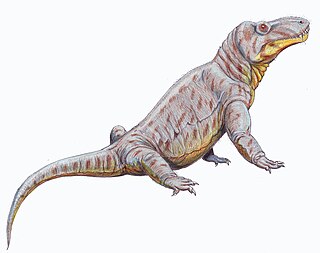 W
WTitanosuchus ferox is an extinct species of dinocephalian therapsids that lived in the Mid Permian epoch in South Africa.
 W
WTropidostoma is a medium-sized herbivorous oudenodontid dicynodont therapsid that lived during the Late Permian (Lopingian) period in South Africa. The first Tropidostoma fossil was described by Harry Govier Seeley in 1889. Later two subspecies were identified. Tropidostoma fossils are an index fossil in a biozone of the Karoo Basin known as the Tropidostoma Assemblage Zone. This biozone is characterized by the presence of this species in association with another dicynodont species, Endothiodon uniseries.
 W
WZapsalis is a genus of dromaeosaurine theropod dinosaurs. It is a tooth taxon, often considered dubious because of the fragmentary nature of the fossils, which include teeth but no other remains.